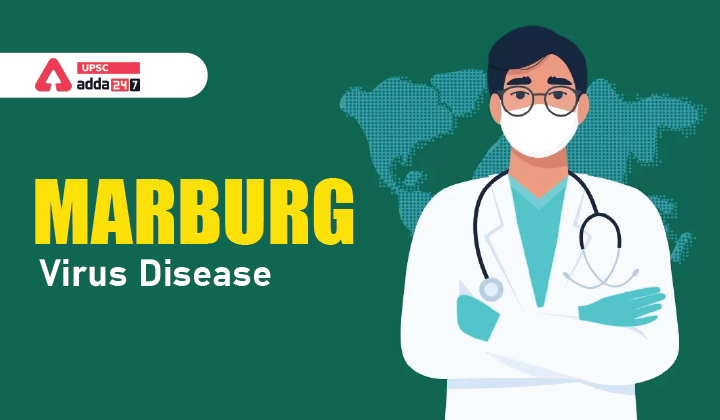Table of Contents
The outbreak of lethal MARBURG virus has taken the world by storm at a time when everyone is just flustered by the spread of Monkeypox which now has been declared as Public Health Emergency of International Concern (PHEIC) by World Health Organization (WHO) and the world is already exhausted from battling the COVID pandemic.
First reported in 1967 in a town called Marburg in Germany and in Belgrade, Yugoslavia (now Serbia). There were simultaneous outbreaks in both cities. It came from monkeys imported from Uganda for laboratory studies in Marburg. The laboratory staff got infected as a result of working with materials (blood, tissues and cells) of the monkeys. Of 31 cases associated with these outbreaks, seven people died.
- Marburg virus disease (MVD), formerly known as Marburg hemorrhagic fever, is a severe, often fatal illness in humans causing viral hemorrhagic fever.
- Rousettus Aegyptiacus, fruit bats of the Pteropodidae family, are considered to be natural hosts of Marburg virus and is transmitted to people through contact with materials (fluids, blood, tissues and cells) of an infected host or reservoir or infected person.
- Human MVD infection results from prolonged exposure to mines or caves inhabited by Rousettus bat colonies.
- Burial ceremonies that involve direct contact with the body of the deceased can also contribute in the transmission of Marburg.
- People remain infectious as long as their blood contains the virus.
SYMPTOMS
- Incubation period (interval from infection to onset of symptoms) varies from 2 to 21 day
- High fever, severe headache and severe malaise.
- Severe watery diarrhea (can last for a week).
- Abdominal pain and cramping.
- Nausea and vomiting can begin on the third day.
- Non-itchy rash in most patients between 2 and 7 days after onset of symptoms.
- Hemorrhagic manifestations between 5 and 7 days with fatal cases usually have some form of bleeding, often from multiple areas.
CHALLENGES WITH MARBURG VIRUS DISEASE
- It is difficult to clinically distinguish MVD from diseases such as malaria, typhoid fever and other viral hemorrhagic fevers.
- There is no approved antiviral treatment or vaccine for MVD as of now.
TREATMENTS AND VACCINES
- There are no vaccines or antiviral treatments approved for MVD. supportive care – rehydration with oral or intravenous fluids – and treatment of specific symptoms, improves survival.
- Supportive care – rehydration with oral or intravenous fluids – and treatment of specific symptoms, improves survival can sustain the spread and improves survival.
DEVELOPMENTS IN VACCINATION
- Monoclonal antibodies (mAbs) under development and antivirals such as Remdesivir and Favipiravir that have been used in clinical studies for Ebola Virus Disease (EVD) could also be tested for MVD or used under compassionate use/expanded access.
- Zabdeno (Ad26.ZEBOV) and Mvabea (MVA-BN-Filo) could potentially protect against MVD, but the efficacy has not been proven in clinical trials.
PREVENTION AND CONTROL
Community engagement is key to successfully controlling the outbreaks. Raising awareness of risk factors for Marburg infection and protective measures that individuals can take is an effective way to reduce human transmission.
Risk reduction messaging should focus on several factors:
- Reducing the risk of bat-to-human transmission arising from prolonged exposure to mines or caves inhabited by fruit bat colonies
- Reducing the risk of human-to-human transmission in the community
- Communities affected by Marburg should make efforts to ensure that the population is well informed, both about the nature of the disease itself and about necessary outbreak containment measures.
- Outbreak containment measures include prompt, safe and dignified burial of the deceased, identifying people who may have been in contact with someone infected with Marburg and monitoring their health for 21 days, separating the healthy from the sick to prevent further spread and providing care to confirmed patient and maintaining good hygiene and a clean environment need to be observed.
- Reducing the risk of possible sexual transmission.
WHO response
WHO aims to prevent Marburg outbreaks by maintaining surveillance for Marburg virus disease and supporting at-risk countries to develop preparedness plans. The following document provides overall guidance for control of Ebola and Marburg virus outbreaks:
When an outbreak is detected WHO responds by supporting surveillance, community engagement, case management, laboratory services, contact tracing, infection control, logistical support and training and assistance with safe burial practices.
WHO has developed detailed advice on Marburg infection prevention and control:



 TSPSC Group 1 Question Paper 2024, Downl...
TSPSC Group 1 Question Paper 2024, Downl...
 TSPSC Group 1 Answer key 2024 Out, Downl...
TSPSC Group 1 Answer key 2024 Out, Downl...
 UPSC Prelims 2024 Question Paper, Downlo...
UPSC Prelims 2024 Question Paper, Downlo...
